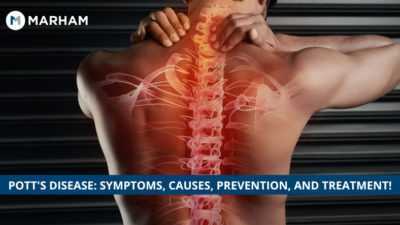Pott’s Disease is a rare condition that occurs in patients with Tuberculosis (TB). It is also known as tuberculous spondylitis or tuberculosis of the spine.
It is one of the oldest documented illnesses in human history, and it is the most frequent extrapulmonary type of TB. In densely populated developing countries, the morbidity and death rate from spinal tuberculosis is greater than for other diseases.
All the information related to Pott’s disease like its causes, symptoms, diagnosis, prevention, and treatment has been listed in this health blog.
What is Pott’s Disease?
“Spinal TB accounts for 2% of all cases of TB, 15% of the cases of extrapulmonary TB and 50% of the cases of skeletal TB.” – Research on Pott’s Disease
Pott disease, also known as tuberculous spondylitis or TB of the spine, is a condition caused by tuberculosis bacillus infection of the spinal column, or vertebral column.
This disease is characterized by spinal softening and breakdown, which frequently results in a hunchback curvature of the spine. Pott’s disease is based on Sir Percivall Pott’s name, an English physician who identified it in a monograph released in 1779.
Cause of Pott’s Disease:
Pott’s spine or spinal TB can occur when TB-causing germs Mycobacterium tuberculosis gets into the lungs and this infection in the lungs extends to the spine.
Tuberculosis can move from the lungs to the spine if left untreated. It is most common in developing countries owing to a lack of access to healthcare and low-income residents who cannot afford medicines.
When this happens, the person suffers from “spinal arthritis.” Tuberculosis bacteria infiltrate the spinal cord and, if infected in two adjoining spinal joints, limit the nutritional flow to that area of the back.
The spinal discs eventually degrade, resulting in major back pain, difficulties standing or walking, nerve loss, and, in severe instances, paralysis.
What are the Signs and Symptoms of Pott’s Disease?
Unlike normal TB, which mostly affects the lungs, Pott’s disease is easily identified due to the extreme curvature of the mid to lower spine that the infection causes.
Some common signs and symptoms of Pott’s spine include:
- back discomfort
- soreness
- paraplegia or paraparesis
- kyphotic or scoliotic abnormalities
- deformity
- instability
- neuro deficit
- cold abscess
- weight or appetite loss
- fever
- malaise/ fatigue


How is Pott’s Disease Diagnosed?
Doctors might recommend the following diagnostic tests for tuberculosis detection:
- X-ray of the chest
- Sputum cultures
- Blood analysis
- Biopsy of tissue
- Mantoux Tuberculin skin tests (results are positive in 84-95% of Pott’s disease patients)
- CT scanning (detects early lesions and is more successful than ultrasound in identifying the form and calcification of soft tissue abscesses)
- MRI (the gold standard for assessing disk-space infection and osteomyelitis of the spine)
- Polymerase Chain Reaction (PCR) ( for quick detection and diagnosis of numerous mycobacterium strains)
How can you Prevent Pott’s Disease?
Some preventive measures that you should take for the prevention of spinal tuberculosis or Pott’s disease are:
- BCG Vaccination: All newborns living in TB endemic regions or at high risk of exposure to TB should receive BCG immunization.
- During Travel: Travelers should avoid close contact or spending extended periods of time with known tuberculosis patients in congested, confined places.
- Get Tested: If you think you have been exposed to people with tuberculosis for an extended period of time, such as medical personnel, inmates, or homeless shelter populations, get a tuberculin skin test (TST) or interferon-gamma release assay (IGRA) test.
Risk Factors for Pott’s Disease:
According to a study, some established risk factors for tuberculosis are:
- prolonged exposure to infected people
- immunodeficiencies (HIV, alcohol, drug misuse)
- overcrowding
- malnutrition
- poverty
- lower socioeconomic status
What is the Treatment of Pott’s Disease?
Since this disease involves the spine a team of Orthopedic surgeons, Neurosurgeons, and Rehabilitation doctors might work together to form a treatment. Research suggests that a combination of surgical and medical treatment can give excellent results for Pott’s disease.
There are different treatment options for Pott’s disease. They are:
1. Medicines
The Centers for Disease Control and Prevention (CDC), the Infectious Diseases Society of America, and the American Thoracic Society all recommended a 4-drug regimen for Pott disease.
The two common drugs used for treating Pott’s disease which should be taken for the duration of the treatment are
- Isoniazid
- Rifampin
During the first two months of therapy, additional medications your doctor might also suggest other drugs like
- pyrazinamide
- ethambutol
- streptomycin
Your doctor might recommend other medicines according to your condition.
2. Surgery
You might need surgery if the Spinal TB has progressed. A combination of surgery and an ultra-short-term of therapy appears to produce equivalent results to a combination of surgery.
Consult a Doctor Online!
The treatment of Pott’s Disease is available in Pakistan and you now even consult online with the Best Doctors Online via the Marham app at affordable rates.
Can’t Find the App?
| Android | IOS |
|---|---|
  |
  |
FAQs
What is the cause of Pott’s disease?
Pott’s disease occurs when the TB virus enters the spine if it is left untreated in the body for a long time. Some common risk factors for Pott’s disease include malnutrition, being in a low-income household, interaction with TB patients, and traveling to unsensitized places.
Is Potts disease curable?
Pott’s Disease is a result of a lack of treatment over a long period of time; conversely, a lengthy period of medication is often needed to fully treat the condition. But, it is treatable and can be managed through a rigorous medication regimen or surgery.
Why is TB spine called Potts spine?
TB spine is called Pott’s spine after Sir Percival Pott who described tuberculous inflammation of the spine in his monograph in 1779. His patients were mostly newborns and young children.

